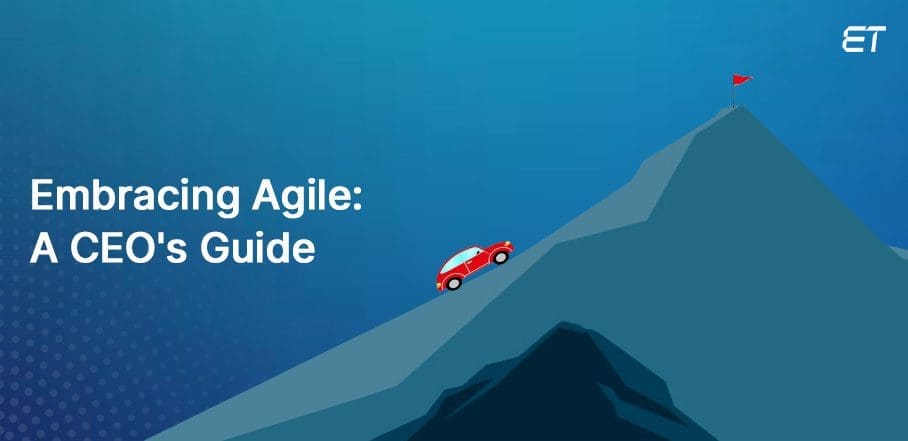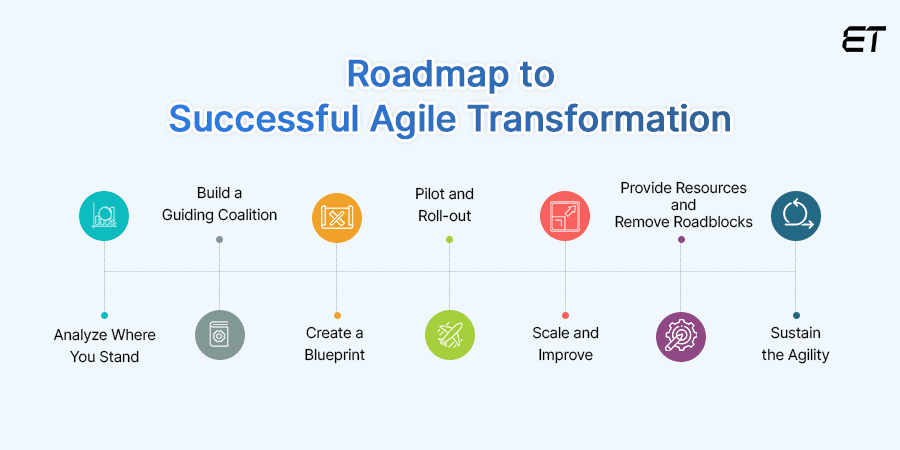
7-Step Roadmap: A CEO’s Guide to Successful Agile Transformation
Struggling to keep up with market demands, technological advancements, and evolving customer expectations? Old strategies that worked in the past slowing you down?
Well, agile transformation can be your game-changer!
Think of your business as a classic car— once a symbol of innovation and reliability, now a drain on your wallet with every mile. While it may have served you in the past, it struggles to keep pace with the newer models on the road today.
Just as technology has transformed the automobile industry, agile transformation offers a revolutionary approach to revitalizing your business. It helps you streamline workflows, accelerate decision-making, adapt and innovate, and most importantly, deliver greater value to your customers.
In this start-to-finish guide, we cover everything— from discerning your role as a CEO in agile transformation to outlining the perfect roadmap to successful agile transformation. We also dive into two successful cases of agile transformations to help you get started on your agile journey.
So, read on!
The Role of CEOs in Agile Transformation
Embracing agility isn’t just about software development; it is about reimagining how your entire business operates. As CEOs and business owners, you must steer your company toward agility to ensure a competitive edge in the market. Here’s how:
Vision Setting and Strategy
Satya Nadella, CEO of Microsoft once said, “Our industry does not respect tradition, it only respects innovation.” As a CEO, you play the pivotal role of outlining the vision and strategy for adopting agile. This means defining what agility means for your organization, why it is important and then aligning it with your business goals.
Remember, no one knows the history and targets of your company better than you, and clear direction sits at the heart of a successful agile digital transformation! Having said that, it is important to arrive at it by involving your department heads who are aware of day-to-day challenges.
Once your vision and strategy are in place, communicate the same through daily conversations, newsletters, and other channels to ensure it is understood across all levels of your organization and consistently upheld.
Lead through Others
For a successful agile transformation, the right decision-makers should be part of the change. Simon Sinek, a renowned voice in leadership, argues that “when we tell people to do their jobs, we create workers. [But] when we trust people to get the job done we create leaders.”
So, lead through others to cultivate a culture where each associate feels valued, motivated, and confident to contribute to the success of your brand.
This distributed approach will not only accelerate decision-making but will also allow you to tap into the diverse skills, experiences, and perspectives within your organization.
Embrace Agile Culture
Agile is not simply a set of strategies or a framework, it is a culture and mindset. Renowned author and management consultant, Peter Drucker, famously said, “Culture eats strategy for breakfast!”
As a CEO you have the reins to shape this culture by promoting collaboration, transparency, and continuous improvement. So, encourage organic communication, celebrate individual successes, and most importantly allow your associates the room to make mistakes and learn from them.
By empowering your teams to ideate, experiment, innovate, and take ownership, you lay the groundwork for a successful agile transformation.
Remove Roadblocks
Leading expert on lean manufacturing, Shigeo Shingo, warns that “the most dangerous kind of waste is the waste we do not recognize.” So, as CEO, it is your responsibility to identify and remove roadblocks that may affect your agile digital transformation.
This includes breaking down silos, investing in employee training and resources, and streamlining in-house workflows to allow your teams to focus on what truly matters— delivering value to customers.
Champion Customer Focus
Agile is all about delivering customer value. So, a customer-centric approach is key to the success of your brand.
Former CEO of Microsoft, Bill Gates, once rightly said, “Your most unhappy customers are your greatest source of learning.” As a business owner, you must hence encourage your associates to engage directly with customers, embrace feedback, and iterate your products or services to align with customer needs.
By keeping the customer at the center of everything you do, your agile practices help you keep up with market trends.

7 Steps to a Successful Agile Transformation Roadmap

Transforming your brand to agility will take time. A figure-as-you-go approach may not be very efficient. To help you out, we leave you with a structured seven-step agile transformation roadmap.
1. Take Stock of Where You Stand
Change begins by first understanding where you are and where you want to go.
So, conduct a thorough assessment of the current state of your company.
- Analyze existing procedures, culture, practices, and in-house resources.
- Identify pain points, bottlenecks, and areas that need improvement.
2. Build a Guiding Coalition
Next, establish who would lead the agile efforts.
- Meet with your department leads, stakeholders, and executives (if possible) to incorporate their feedback, resolve any pushback, and build a shared vision for change.
- Form a cross-functional guiding coalition that understands the ROI and is committed to the change.
3. Create a Blueprint
With your coalition in place, define how you’d go about the change and what you’d want to get out of your agile transformation journey.
- Outline a detailed transformation plan with clear objectives and milestones. This would include how you’d want to differentiate your brand in the market or what competitive edge you wish to attain.
- Prioritize agile initiatives based on impact, feasibility, key business goals, and most importantly customer needs.
- Plan out how you’d want your teams to collaborate, on what goals, and how they’d be managed and guided.
- Set a timeframe and budget for the transformation.
4. Pilot and Roll-out
As Walt Disney aptly puts it, “The way to get started is to quit talking and begin doing.”
- So, start with pilot projects with a 3-month timeframe.
- Collect feedback regularly and learn from what worked for you and what didn’t.
- Address pushback if any.
- Analyze which strategies need to be adjusted, updated, or thrown out.
- Next, roll out agile practices gradually across your organization.
5. Provide Resources and Remove Roadblocks
Guidance and support go a long way in preventing your employees from getting overwhelmed by the change.
- Hence, as a part of your pilot project, provide additional resources and training to facilitate a smooth agile adoption.
- Identify and remove roadblocks to create an environment that enables your team to focus on delivering value.
- Lastly, set monthly or quarterly incentives in place to reward employees for their hard work.
6. Scale and Improve
Once your pilot is a success, you must look to scale your agile strategies across different pain points.
- Build a solid communication plan. Replace silos with cross-collaboration to bring transparency and continuous learning.
- Encourage your employees to share knowledge, experiment, and innovate together. However, ensure there aren’t too many dependencies that result in your teams waiting on each other.
- Introduce horizontal hierarchy wherever possible. Encourage individuals to set their own goals, take initiative, and self-manage. Team leaders should guide and support and not dictate.
7. Risk Management to Sustain the Agility
It’s important to understand that even the best agile strategies might fail or not suit your organizational structure.
- So, give your employees the room to fail to learn from their failures.
- Also, develop risk mitigation plans to address the uncertainties associated with your agile transformation strategy. This can include conducting risk workshops, analyzing user stories, prototyping, utilizing a risk matrix, or other approaches tailored to your company’s needs.
- Conduct regular check-ins to monitor and reassess the outlined risks to sustain your agile journey.
Agile Transformation Case Studies
To help you understand the power of agile transformation better, we leave you with two compelling case studies of companies that went on to become a global brand with agile practices.
Let’s uncover the key factors that contributed to their success.
Spotify

Music streaming giant Spotify founded in 2006 became a global dominance boasting a user base of 602 million listeners, spanning across 180 markets worldwide. Despite its humble beginnings as a Swedish start-up, it revolutionized the music industry.
How?
It’s an agile framework! — the ‘Spotify Model’ or ‘Spotify Tribe’.
Background
As Spotify grew, it struggled to maintain its innovative culture. Siloed teams and departments affected communication and collaboration as the company expanded across different locations and time zones.
In its early years, the company relied on the Scrum framework which worked well for its small team. But, as the company grew rapidly, scaling Scrum became a challenge. To maintain its agility and allow a free flow of ideas, they came up with their unique organizational model.
‘Spotify Model’ or ‘Spotify tribe’
The Spotify model organizes around work instead of focusing on strict hierarchies. It structures teams into six key elements to allow autonomy, flexibility, experimentation, transparency, and trust building.
Squads: They are cross-functional teams of 6-12 individuals focused on specific components or features, operating autonomously like a mini-startup with its own goals and roadmap. This fosters self-management. Each squad has a product owner (PO) who oversees the project vision and workflow and an agile coach who guides the team
Tribes: When multiple squads collaborate on broader initiatives they form a tribe. This helps bring in adaptability and creativity and also helps with team engagement and productivity. Not surpassing more than 150 members, they are led by one or more tribe leads.
Trio: It includes a tribe lead, a product lead, and a design lead that together guides a tribe through a three-pronged approach to align perspectives and steer feature development.
Alliance: It is formed by two or more trios collaborating on larger goals.
Chapters: They give individuals with similar skills and expertise across squads, a platform to knowledge share and facilitate growth within their respective fields. For instance, backend developers and UX designers may come together to uphold engineering standards. While squads facilitate individuality, chapters led by a chapter lead ensure alignment with border company objectives to deliver value to end-users.
Guilds: As informal communities, they include members across the entire organization to facilitate the exchange of solutions for continuous self-improvement. Unlike chapters, they are open to everyone since a problem faced by a specialist may already be solved by a colleague from a different tribe.
Additionally, there are system owners and a chief architect who guide and advise but do not have the final say.
Results
Its Agile framework allowed Spotify to break down silos to facilitate collaboration which in turn accelerated its product development cycle, enabling faster delivery of new features and updates to users. It helped the company adapt to market changes more quickly and incorporate user feedback faster. Additionally, it made room for failure, which was seen as an integral part of the continual self-development process.
Interestingly, Spotify themselves do not implement their model anymore, and have instead adapted it to their changing needs. Trio and Alliances are new features that were added as a result.
LEGO

Renowned Danish toy company, The LEGO Group, has been a household name since its establishment in 1932. But with digital toys and drones flooding the toy industry, you might wonder how it has maintained a loyal customer base.
The secret lies in its agile practices!
Background
In the 1990s and early 2000s, LEGO’s product line was outdated, resulting in severe financial losses and a sharp fall in market share which nearly bankrupted the company. To combat these challenges and stay relevant in the ever-evolving toy industry, the company underwent agile transformation in 2004 under its new CEO, Jorgen Vig Knudstorp.
LEGO’s Agile Journey
Renowned Danish toy company, The LEGO Group, has been a household name since its establishment in 1932. With digital toys and drones flooding the toy industry, you might wonder how it has maintained a loyal customer base.
- Cross-team Alignment: Faced difficulty in getting teams to collaborate without creating dependencies that delay processes.
- Client Collaboration: Struggled to set realistic expectations without over-committing.
- Release Planning: Failed to prioritize work across their numerous sprints, teams, and products.
- Platform Development: Found it difficult to come up with long-term innovation plans that weren’t one-off solutions.
To address these issues, 20 teams at LEGO underwent realignment which included the following:
- Adopting Agile methodologies like Scrum and Kanban to streamline product development.
- Created a teams-of-teams structure where multiple teams worked towards the same objective.
- Introduced a consistent sprint duration across teams to manage their dependencies.
- Held big-room planning events every 2 months to align goals further and create product-oriented teams.
Additionally,
- The company reduced the number of product lines and focused on its core building block business.
- Invested in interactive products like the Lego Mindstorms robotics kit.
- Re-engaged with its end users through focus groups, surveys, and play-testing sessions to understand customer preferences.
- Leveraged social media and used user-generated content to build a strong brand image.
Results
Their agile strategies allowed their digital teams to quickly respond to the needs of the sales team to create customer-focused pop-up stores that helped boost sales.
LEGO’s revenue grew from $1.4 billion in 2003 to $5.2 billion in 2015, becoming the largest toy company in the world in terms of market share. With its revamped product line and marketing efforts, adults became a huge chunk of their customer base.

How to Measure Successful Agile Transformation?

Agile transformation is not simply the adoption of a few agile practices, it is a cultural shift that needs to be continually evaluated to yield results. So, to measure the success of your agile transformation efforts focus on the following:
Performance Metrics
Start by keeping track of your key performance indicators (KPIs)— product quality, time-to-market, and employee productivity before and after the implementation of agile frameworks.
Customer Feedback
Gather feedback from your end users to get additional information on product quality, responsiveness to market needs, and overall customer satisfaction.
Business Outcome
Lastly, identify and analyze any change in business outcomes such as revenue, market share, or any competitive edge gained or lost.
Agile transformation is not a one-time journey, but instead an ongoing effort. So, regularly assess and adjust your efforts to ensure your agile practices remain relevant and aligned with your long-term business goals.

Are You Ready to Be Agile?
As we wrap up our guide on how to lead a successful agile transformation, it is evident that there is no one-size-fits-all approach. Instead, leading a successful agile transformation requires a deep understanding of the organizational structure, unwavering commitment to continual improvement, and the courage to challenge the status quo.
Just keep in mind that agile transformation is a marathon, not a sprint. As a CEO, your ability to persevere through complexities, inspire your team, and stay focused on your end goals, will determine the success of your agile efforts.
Irrespective of whether you’re just starting your agile transformation journey or looking to incorporate new practices, our seven-step roadmap will bring you tangible results.
But if you still find yourself unsure as to where to begin, partnering with agile experts can give you the competitive edge you need in today’s market!
Frequently Asked Questions
1. What challenges should I expect when leading an agile transformation?
While leading an agile transformation you may face resistance to change or a lack of executive support. To overcome the same, involve your senior leadership in the decision-making process early on, provide resources and training across all levels of the organization, communicate the potential ROI, and most importantly, start small with pilot projects and gradually scale.
2. How long does it take to see the effects of agile transformation?
The timeline for gaining tangible benefits from your agile strategies would vary depending on the size of your organization, the composition of your employees (including factors like location, time zones, skills and experience levels, and remote vs onsite work settings), the complexity of projects, level of commitment to agile principles.
However, organizations typically reap benefits within a few months to a year after organized agile transformation.



